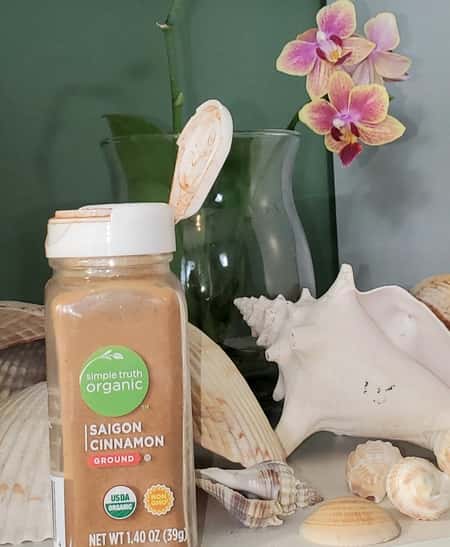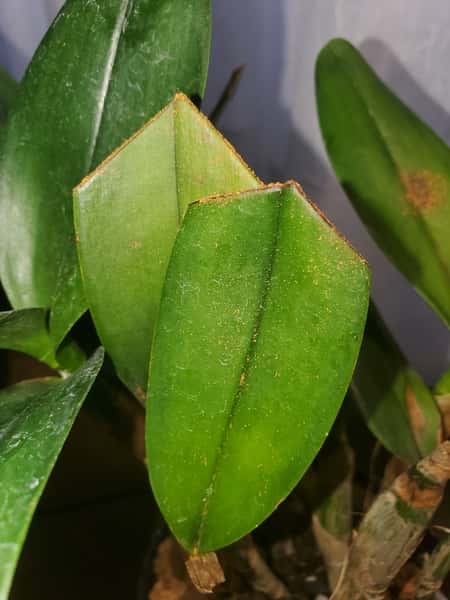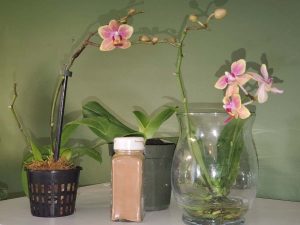The most common myth in the use of cinnamon for orchids:
“Place cinnamon on your orchid roots. That helps them heal.”
Right?
NO—ABSOLUTELY WRONG. There is a lot of wrong advice about cinnamon on the internet that just makes me want to shiver—especially when it comes to applying cinnamon on orchids.
It seems like if you tell a lie once, it’s still a lie, but if you publish it on the internet, it miraculously becomes true. Cinnamon has become another one of these tales (just like watering with ice cubes) that has caused misinformation and has had a hand in the death of many orchids.
Cinnamon is not all bad for orchids. In fact, it has many positive properties. The health benefits of cinnamon for your own body are extensive, and can be read about in this article published by Healthline. Made a firm believer out of me.
published by Healthline. Made a firm believer out of me.
Yet, when it comes to orchids, the benefits of cinnamon are not so pronounced.
How does cinnamon help my orchid? Cinnamon for orchids should be used only as a way to dry up open wounds in leaves, preventing bacteria and infections to enter the newly exposed area. Never use cinnamon on orchid roots, since the interaction with the velamen will cause their death due to severe dehydration. Always use cinnamon in a controlled manner and in small doses.

First, pick the right cinnamon.
There are two types of cinnamon on the market: Cassia and Ceylon.
The first, Cassia, is the most sold in supermarkets and grocery stores. Cassia has large amounts of coumarin, which can be harmful to you (and your orchid, but I’m assuming here that you’ll use it in your cooking, too).
If you can find Ceylon, buy this one. Sometimes it is called the Mexican Cinnamon. Usually it is only found in health stores and specialty shops, but it’s worth the search. The percentages of coumarin in the Ceylon variety is a lot lower.If you can’t find it in your local shop, you can get this one on by Simply Organic on Amazon (Affiliate Link).
Cinnamon Dries Out Fresh Wounds on Orchid Leaves
Cinnamon is a desiccant, which means it dries out the environment around it. This is why you can’t swallow a teaspoon of cinnamon pure. It would be like eating baby powder.
It would literally dry your throat up, and make you throw up. If you place cinnamon on your skin, it will start pulling the moisture out of your skin, and in a couple hours, you’ll have a huge red mark. This is what it does to the orchid cells, too.
After you used sterilized scissors to cut off the infected orchid leaf, the new tissue is exposed to air and pathogens. Bacteria and viruses and float into the open wound, full of moisture, nutrients, and water. Cinnamon applied to the open wound on an orchid will dry up the cells, killing them. This creates a closed sealant, an exterior that is hard to penetrate. Some people use candle wax, which does the same thing.
I personally don’t, because I can’t imagine that would feel good for the orchid, but also because I can’t seem to drip the wax where I want it to go and end up with a waxed orchid with an open wound.
The only properties that cinnamon will have on your orchid, besides making it smell nice, is severely drying up the places that it is placed.
Image credit: Orchideria ©2020

Cinnamon as an Orchid Bactericide
There is not enough evidence to support the theory that cinnamon is a bactericide (…and here is where the objections start pouring in the comment section. Let me explain before you click off Orchideria and search another page.)
What has happened over time, is that people have seen how well that cinnamon has worked in sealing off the open wounds on the orchid leaves, that they have added this misconception that the cinnamon will fight off bacteria, too.
Cinnamon doesn’t kill bacteria, but it can. Cinnamon has never been commercialized as a bactericide.
The bacteria die as an after effect of the cinnamon, not the cinnamon itself. For this reason, cinnamon wrongfully got the reputation as being a bactericide.
In the end, it’s all the same… Bacteria dead—orchid alive.
But here’s what really happens: cinnamon will desiccate the area and absorb both water and humidity necessary to live. Drying up with the environment, bacteria die when cinnamon is applied on the orchid wound.
Cinnamon suffocates the open cells wounds where you made the cut and everything else it comes in contact with, too. Most bacteria can’t survive without water and end up withering, eventually suffocate.
Bacteria brown spot has stopped spreading and your orchid is now healthy. In the long run, cinnamon is considered a bactericide and does eventually kill bacteria. It’s a desiccant, and removing water from the cells is what kills the bacteria.
Cinnamon not only hinders bacteria, but larger critters, too. According to a study published in the ISHS Acta Horticulturae, “Clove and cinnamon essential oils have been recently considered as effective alternative fumigants against thrips and mealybug, which are the major pests infecting exported orchid cut flowers in many countries.”
This doesn’t come as a help to the orchid, either. The plant pays the price, and in the end, after using cinnamon, the author J. Pumnuan says that the prolongated use of cinnamon “reduced flower quality, leading to increased weight loss and petal discoloration.” *The reference to this article is at the end.

Does cinnamon work as a bactericide?
Yes… but know what you’re doing.
When you get brown spots, or black rot, the most used advice is to apply cinnamon after spraying your orchid down with
Physan 20 or Hydrogen Peroxide 3%.
The hydrogen peroxide is my favorite.
Works wonders.
How to Use Cinnamon as a Bactericide for Orchids
If you absolutely want to test the bactericide theory of cinnamon on your orchid, you’ll have to add glue to the cinnamon.
Cinnamon itself absorbs water, that is why in your spice rack, it is the lowest of all humidity tolerant spices. Anything over 40% humidity in your cupboard will cause cinnamon to clump together. Other spices can tolerate higher humility, around 50 to 60%.
This is why you’ll have to add glue to hold it together in a small ball, to stick to the orchid leaf. If you add just a drop of water, it will run down the orchid, drying up everything it touches.
Mix a drop of your kid’s school glue, the white stuff that you have laying around, and add cinnamon to it. Drop a small amount of this onto the specific spot that bacterial brown spot has occurred, and in a few days, it should have taken care of the problem.
This is the recommended method—do I use it? No. I prefer to cut off the leaf. I find that I have a harder time controlling bacterial brown spot and it spreads quicker than cinnamon can fix it. But if you want to try it, it’s worth a shot.
As with all orchid growing, you have to find a way that works for you, and not what everyone else is doing.
Does Cinnamon Reduce Inflammation in Orchids
Huh? Inflammation? Where is your orchid inflamed? Inflammation is a typical human response to a bacterium that has infected the body. Your temperature rises. The area becomes red, tender to the touch. Pus usually runs from the wound.
I don’t see orchids having this same reaction. See what I’m getting at here? Many people just repeat what they’ve heard before without properly thinking about the implications of what they are saying.
Orchids don’t get inflamed. Plants don’t get inflammation. People do. What plants can do is become infected with bacteria and viruses and die because of it.
This is why the proper horticultural medicine is advised, to fix the specific ailment. If you’re wondering what your orchid might have, check out this article, that has the most common problems found in orchids, but please don’t say your orchid has an inflammation.
If your orchid has a puffy leaf, or a swelling with a slight discoloring, you might be dealing with edema. Edema, just like in humans, is the swelling of cell tissue, and in the orchid’s case, has to due with over-watering. The healthy roots have absorbed too much water and there is no where to store it in the leaf. The evaporation process is slow, so the leaf “puffs up”.
This is not an inflammation and cinnamon will not cure it.
A common misconception also about inflammation is that plants don’t get inflammation, but they can help cure it. In fact, there are several articles about Indian tribes who used the pseudobulbs to cure inflammation. After grinding the bulbs up and used a flour over their food, the results are rather impressive.
This is not a myth, but science has yet to prove it. Wise tale or not, some edible orchids have anti-inflammatory properties….and cinnamon is not in those recipes.
Cinnamon and Orchid Roots: Dangerous Combination
After taking an orchid out of its original pot to repot, the common practice is to check the roots, and remove any old dead or decaying material. Roots, pseudobulbs, and leaves alike are all inspected and treated.
When a place on the orchid leaf looks like it needs to be cut, either because of bacterial brown spots, fungus infections, black rot, sunburn, physical damage during handling, or other reasons, it’s time to get the pruning shears.
After removal, the new tissue is now exposed to new pathogens, without a layer of protection. Orchids have a natural line of self-defense, which could be compared to the immune system in humans.
They detect when a problem has arrived, and produce enzymes to promote the healing of the dead or damaged plant cells. Your orchid is not fully dependent on your care, so don’t feel like it will die or thrive specifically because of your treatment (or lack of).
Orchids know how fight of bacteria, if not, they never would have survived thousand of years in nature without our help. Their plant cells sense the damage and start the repairing right away. Extra nutrients are necessary for this, so you might see a slowing in leaf or root production, or the orchid might not flower that year. Rationing of nutrients—we could learn a lot.
When on a leaf, the use of cinnamon is beneficial, as explained above. But when the roots are cut due to these same issues, mainly root rot, cinnamon is too harsh. It will interact with the velamen and dry out the root tissue. You’ll end up killing the orchid roots instead of treating them. Cinnamon should never be used on orchid roots due to its high desiccant properties.
You shouldn’t be exposing new root growth in the first place, only cutting the roots where it is still bad and mushy. If you cut the old root and find a healthy green center, accept that you made a little mistake, but don’t treat it with cinnamon.
Never do this.
The small portion of bad, black or mushy roots that you left on your orchid will not hinder the plant in any way. It will not decompose your potting media, or change the pH of your plant, or anything of the sort.
This is one, simple, small place that has died. The dead portion is a natural sealant, and no bacteria will enter through the dead material, unless what is already there. When you cut above the orchid root that is still healthy, you expose a new, fresh, entrance place for bacteria, multiplying the problem. In either case, cinnamon is not used.
Don’t sprinkle cinnamon over the orchid rots thinking your doing it a favor, or aiding it in any way.
The roots don’t have the same cell structure as the leaf and can’t defend themselves as good as the leaves can.
The roots that come into contact with the cinnamon will die off, just like the rash that forms on your skin if you leave cinnamon in contact too long.

Cinnamon for Treating Black Rot in Orchids
Another myth appears in the cinnamon department. Cinnamon does very little for black rot in orchid roots. Even though it is a desiccant, it works for leaves but not stems, roots, crowns, or any other area of your orchid.
If you read the black rot care page from the American Orchid Society , it recommends cinnamon as a treatment for fungicide. Since fungus feed on bacteria, and cinnamon doesn’t allow bacteria to live, then yes, it does work.
, it recommends cinnamon as a treatment for fungicide. Since fungus feed on bacteria, and cinnamon doesn’t allow bacteria to live, then yes, it does work.
The same article also lists several other products you can use. “Drenching the affected plant with fungicide is also an option. Drenches of a protectant fungicide such as Truban or Terrazole are recommended if the disease is diagnosed early. For more advanced cases, a systemic fungicide such as Aliette or Subdue is more effective. Captan, Dithane M-45 and Physan 20 have also been recommended by some growers for control of black rot.” (Source: http://www.aos.org/orchids/orchid-pests-diseases/black-rot.aspx)
Cinnamon is not a scientifically proven method, but if you can’t get a hold of the right products, it’s worth saving your orchid with cinnamon.
Don’t Stop Learning!
If you want to be included in more information and get a 14-page fertilization guide, please sign up for my newsletter. I don’t spam, but send emails out bi-monthly with some curious topics of interest. If you want more information, click here to go to a specific page on this website where I explain it more in detail.

Also, if you are looking for an orchid journal to keep your notes specifically about orchid care, check out my 2 solutions for that on this page. If note-keeping isn’t your thing, then there is a free excel spreadsheet that you can download. Click here for more information on how to do that.
If you subscribe to my newsletter, I will send you a 14-page guide on the main tips of orchid fertilizer. It is downloadable and you can print it out on your computer. I designed the guide to double up as a coloring book, just to make it fun.
Further Reading Suggestions:
Don’t just take my word for what is written here. Continue researching other articles about applying cinnamon to orchids, because everyone has a different point of view and unique techniques that work for them. Here is another article if you’d like to continue your research on cinnamon and it’s affects (and effects) on orchids:
1) “CHANGES OF CUT ORCHID QUALITY AFTER FUMIGATION WITH CLOVE AND CINNAMON ESSENTIAL OILS” talks abouthow the cinnamon will help close the open wound, but to a cut back the overall health of the plant.
You can download the full 25-page PDF file here .
.
Reference: Pumnuan, J., Khurnpoon, L. and Insung, A. (2015). CHANGES OF CUT ORCHID QUALITY AFTER FUMIGATION WITH CLOVE AND CINNAMON ESSENTIAL OILS. Acta Hortic. 1079, 521-525 DOI: 10.17660/ActaHortic.2015.1079.69 https://doi.org/10.17660/ActaHortic.2015.1079.69
So that’s cinnamon in a nutshell. I know this article is controversial, especially with all the misconceptions about cinnamon on the internet that is circulating around.
I honestly hope that the more people that have access to good information will share this post and help save unhealthy orchids from worse treatment. Just as the false info that if you add ice cubes to your plants, applying cinnamon to the entire plant is just as harmful.
Please leave your comments below about how you’ve treated your orchid with cinnamon and how the results have come out for you. many people will say that they’ve used cinnamon for years and years on orchid roots and never have had a problem.
That’s fine—if it works for you.
Remember, everyone has a different way of cultivating orchids, and the use of cinnamon is just one of those with various ways to go about tackling the problem.
Happy cultivating!


If cinnamon simply works on open wounds by drying/killing the exposed tissue, wouldn’t an alcohol swab do the same and allow more precise application as well?
Hi Daniela,
Thank you for your comment! Cinnamon works better than alchool in terms of beign a dissecant. I agree about the swab in that it’s more precise, but not that it will dry out the plant tissue faster. In matter of days, the place where the cut was made will dry up completely. You can use a cotton swab full of cinnamon, which works well. I wish you well with your orhcid care. Happy Cultivating!
-Amanda
I sprinkled cinnamon on the surface of my orchid media. Now I read it’s bad for the roots. What can I do? My orchid is in bloom.